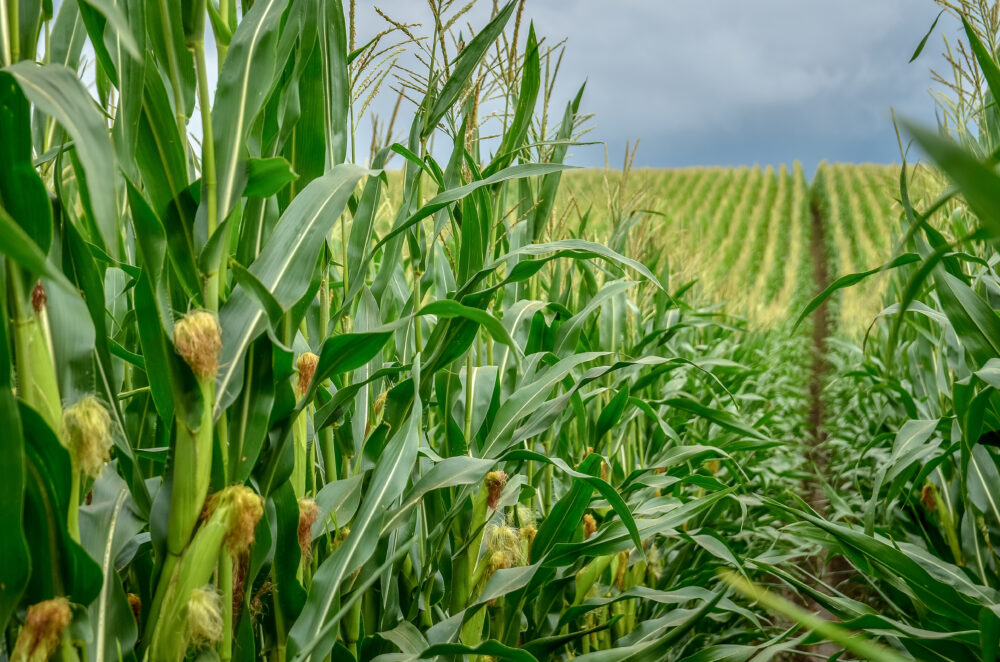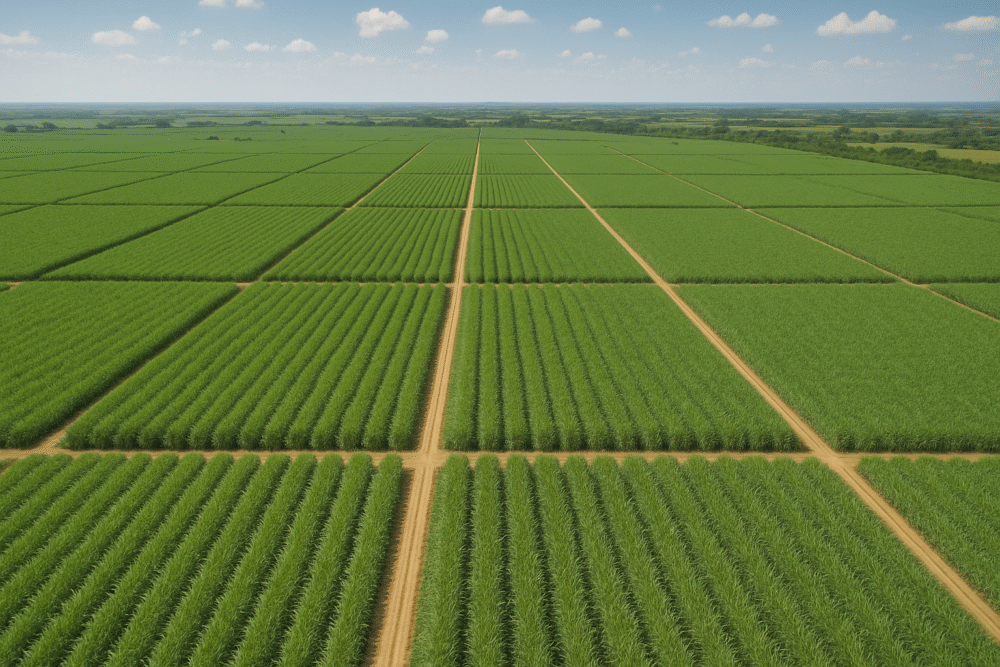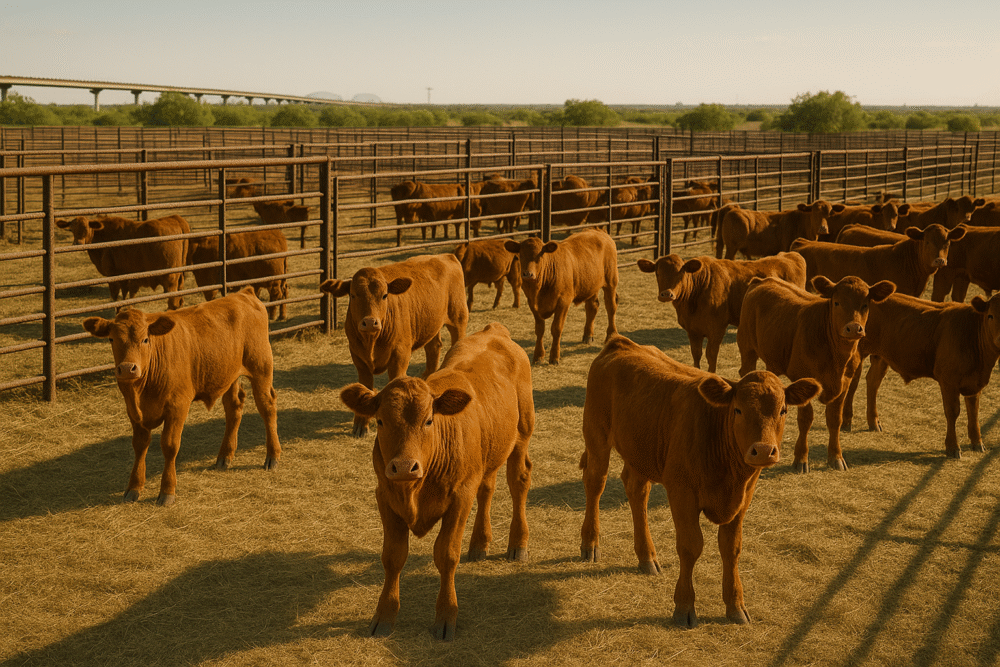Current Corn Futures Market
Share This Story, Choose Your Platform!
Corn Futures Continue Facing Price Pressures
Corn futures play a pivotal role in the agricultural commodities market, serving as a benchmark for global corn prices and a key hedging tool for farmers, traders, and investors. As we approach the 2024/25 marketing year, the fundamental factors that drive corn futures will be crucial for making informed trading decisions. This article provides a comprehensive analysis of the current state of the corn market, leveraging the latest USDA Feed Outlook report from May 2024 to offer insights into production, supply, demand, and price trends.
Historical Seasonality
We mention seasonality in most of our analysis because it is a great place to start. No trade should be made from it alone but combining seasonality with the current fundamentals of supply and demand may provide some confidence. In this case, December corn futures over a 15 year average have seen the height of prices during the first two weeks of June. Again, this does not mean this will happen this time but it is a great place to start. December corn futures are heavily traded because they are the contract following the latest U.S. harvest which comes in September. Late September is also the seasonal low point for December corn futures. Since the pandemic, corn futures like most commodities have seen a ton of volatility in their prices. With the Presidential election in under 6 months, global wars escalating, policy shifts and the rocky relationship the U.S. has with China all of these could factor heavily on corn futures for the 2024/2025 marketing year. The 2023/24 marketing year marked a record production year for the United States, which is expected to have lasting impacts on supply and prices in the upcoming year.
Supply Analysis
Global Production Data:
The USDA report projects global coarse grain production for 2024/25 to reach 1,512.6 million tons, an increase of 10.5 million tons from the previous year. Despite an expected decline in U.S. corn production, higher foreign production, particularly in Brazil and the European Union, will offset this reduction. The U.S. corn crop is projected to be 14,860 million bushels, 482 million bushels lower than the previous year due to reduced planted acreage, forecasted at 90.0 million acres.
Yield and Acreage:
The U.S. corn yield for 2024/25 is forecasted at 181 bushels per acre, consistent with the trend yield presented earlier this year. Planting progress, as of May 6, shows that 36% of the intended corn acreage has been planted, 6% below last year’s pace. Weather conditions have played a crucial role, with recent rains improving soil moisture levels in the Western Corn Belt.
Demand Analysis
Global Consumption:
Global consumption patterns for corn are influenced by various factors, including food, feed, and industrial uses. The USDA report highlights that global corn feed use is expected to grow, offsetting a reduction in food, seed, and industrial use. In the U.S., food, seed, and industrial (FSI) corn use for 2023/24 is raised by 50 million bushels to 6,855 million bushels, with similar expectations for 2024/25.
Ethanol Production:
Ethanol production remains a significant driver of corn demand in the U.S. The USDA report raises the 2023/24 corn use for ethanol production by 50 million bushels to 5,450 million bushels. This increase is supported by favorable blending margins due to low corn and ethanol prices compared to gasoline. The projection for 2024/25 remains steady at 5,450 million bushels, indicating a stable demand outlook for ethanol production.
Export Dynamics
U.S. Corn Exports:
The USDA report projects U.S. corn exports to increase for both 2023/24 and 2024/25 marketing years. For 2023/24, corn export estimates are raised by 50 million bushels to 2,150 million bushels, driven by strong demand from key destinations such as Mexico, Colombia, Japan, China, and Canada. Mexico, in particular, has significantly increased its imports due to poor domestic harvests, with cumulative U.S. corn exports to Mexico totaling 509 million bushels.
Global Trade Outlook:
Despite lower production forecasts for major exporters like Argentina and Brazil, the U.S. is expected to benefit from reduced competition, supporting a higher export forecast of 2,200 million bushels for 2024/25. This highlights the importance of monitoring global production trends and trade policies, as shifts in these areas can significantly impact U.S. export competitiveness.
Price Trends
Corn Prices:
Corn prices are influenced by the fundamentals of supply and demand. The USDA report projects the season-average farm price for corn in 2023/24 at $4.65 per bushel, a slight reduction from previous estimates due to current market conditions. For 2024/25, the season-average farm price is projected to decline further to $4.40 per bushel, driven by larger supplies and a higher stocks-to-use ratio of 14.2%.
Stocks-to-Use Ratio:
The stocks-to-use ratio is a key indicator of market tightness or surplus. For 2024/25, the projected ending stocks-to-use ratio for corn is 14.2%, higher than the current year’s estimate of 13.7%. This indicates a more comfortable supply situation, which the USDA is expecting to exert downward pressure on prices.
Weather and Agronomic Factors
Weather Impact:
Weather conditions play a critical role in determining corn yields and production levels. The USDA report notes that recent rains have significantly improved soil moisture levels in the Western Corn Belt, reducing the percentage of the corn crop under drought conditions to 14%, compared to 29% a year ago. This improvement in weather conditions bodes well for the current planting season and yield outcomes.
Technological and Agronomic Practices:
Advancements in farming techniques and agronomic practices, such as precision agriculture and genetically modified organisms (GMOs), continue to enhance corn production efficiency. These innovations contribute to higher yields and more resilient crops, helping to mitigate the impacts of adverse weather conditions and other challenges.
Government Policies and Subsidies
Agricultural Subsidies and Trade Policies:
Government policies, including agricultural subsidies and trade agreements, have significant implications for the corn market. Subsidies can influence planting decisions and production levels, while trade policies impact export competitiveness. The USDA report highlights the importance of monitoring these policies, as changes can affect both domestic and international markets.
Conclusion
In conclusion, corn futures will be one to watch this growing season. The USDA reports provide critical insights into production, supply, demand, and price trends for the 2024/25 marketing year. With lower U.S. production but higher beginning stocks, strong export demand, and stable domestic usage, the corn market is poised for an interesting year ahead. Traders and investors should closely monitor weather conditions, global production trends, and government policies to make informed decisions in this volatile market.
References
- USDA Economic Research Service. (2024). Feed Outlook: May 2024. USDA Feed Outlook Report
- Read our 2023 Analysis Here
Share This Story, Choose Your Platform!
Current Corn Futures Market
Share This Story, Choose Your Platform
Corn Futures Continue Facing Price Pressures
Corn futures play a pivotal role in the agricultural commodities market, serving as a benchmark for global corn prices and a key hedging tool for farmers, traders, and investors. As we approach the 2024/25 marketing year, the fundamental factors that drive corn futures will be crucial for making informed trading decisions. This article provides a comprehensive analysis of the current state of the corn market, leveraging the latest USDA Feed Outlook report from May 2024 to offer insights into production, supply, demand, and price trends.
Historical Seasonality
We mention seasonality in most of our analysis because it is a great place to start. No trade should be made from it alone but combining seasonality with the current fundamentals of supply and demand may provide some confidence. In this case, December corn futures over a 15 year average have seen the height of prices during the first two weeks of June. Again, this does not mean this will happen this time but it is a great place to start. December corn futures are heavily traded because they are the contract following the latest U.S. harvest which comes in September. Late September is also the seasonal low point for December corn futures. Since the pandemic, corn futures like most commodities have seen a ton of volatility in their prices. With the Presidential election in under 6 months, global wars escalating, policy shifts and the rocky relationship the U.S. has with China all of these could factor heavily on corn futures for the 2024/2025 marketing year. The 2023/24 marketing year marked a record production year for the United States, which is expected to have lasting impacts on supply and prices in the upcoming year.
Supply Analysis
Global Production Data:
The USDA report projects global coarse grain production for 2024/25 to reach 1,512.6 million tons, an increase of 10.5 million tons from the previous year. Despite an expected decline in U.S. corn production, higher foreign production, particularly in Brazil and the European Union, will offset this reduction. The U.S. corn crop is projected to be 14,860 million bushels, 482 million bushels lower than the previous year due to reduced planted acreage, forecasted at 90.0 million acres.
Yield and Acreage:
The U.S. corn yield for 2024/25 is forecasted at 181 bushels per acre, consistent with the trend yield presented earlier this year. Planting progress, as of May 6, shows that 36% of the intended corn acreage has been planted, 6% below last year’s pace. Weather conditions have played a crucial role, with recent rains improving soil moisture levels in the Western Corn Belt.
Demand Analysis
Global Consumption:
Global consumption patterns for corn are influenced by various factors, including food, feed, and industrial uses. The USDA report highlights that global corn feed use is expected to grow, offsetting a reduction in food, seed, and industrial use. In the U.S., food, seed, and industrial (FSI) corn use for 2023/24 is raised by 50 million bushels to 6,855 million bushels, with similar expectations for 2024/25.
Ethanol Production:
Ethanol production remains a significant driver of corn demand in the U.S. The USDA report raises the 2023/24 corn use for ethanol production by 50 million bushels to 5,450 million bushels. This increase is supported by favorable blending margins due to low corn and ethanol prices compared to gasoline. The projection for 2024/25 remains steady at 5,450 million bushels, indicating a stable demand outlook for ethanol production.
Export Dynamics
U.S. Corn Exports:
The USDA report projects U.S. corn exports to increase for both 2023/24 and 2024/25 marketing years. For 2023/24, corn export estimates are raised by 50 million bushels to 2,150 million bushels, driven by strong demand from key destinations such as Mexico, Colombia, Japan, China, and Canada. Mexico, in particular, has significantly increased its imports due to poor domestic harvests, with cumulative U.S. corn exports to Mexico totaling 509 million bushels.
Global Trade Outlook:
Despite lower production forecasts for major exporters like Argentina and Brazil, the U.S. is expected to benefit from reduced competition, supporting a higher export forecast of 2,200 million bushels for 2024/25. This highlights the importance of monitoring global production trends and trade policies, as shifts in these areas can significantly impact U.S. export competitiveness.
Price Trends
Corn Prices:
Corn prices are influenced by the fundamentals of supply and demand. The USDA report projects the season-average farm price for corn in 2023/24 at $4.65 per bushel, a slight reduction from previous estimates due to current market conditions. For 2024/25, the season-average farm price is projected to decline further to $4.40 per bushel, driven by larger supplies and a higher stocks-to-use ratio of 14.2%.
Stocks-to-Use Ratio:
The stocks-to-use ratio is a key indicator of market tightness or surplus. For 2024/25, the projected ending stocks-to-use ratio for corn is 14.2%, higher than the current year’s estimate of 13.7%. This indicates a more comfortable supply situation, which the USDA is expecting to exert downward pressure on prices.
Weather and Agronomic Factors
Weather Impact:
Weather conditions play a critical role in determining corn yields and production levels. The USDA report notes that recent rains have significantly improved soil moisture levels in the Western Corn Belt, reducing the percentage of the corn crop under drought conditions to 14%, compared to 29% a year ago. This improvement in weather conditions bodes well for the current planting season and yield outcomes.
Technological and Agronomic Practices:
Advancements in farming techniques and agronomic practices, such as precision agriculture and genetically modified organisms (GMOs), continue to enhance corn production efficiency. These innovations contribute to higher yields and more resilient crops, helping to mitigate the impacts of adverse weather conditions and other challenges.
Government Policies and Subsidies
Agricultural Subsidies and Trade Policies:
Government policies, including agricultural subsidies and trade agreements, have significant implications for the corn market. Subsidies can influence planting decisions and production levels, while trade policies impact export competitiveness. The USDA report highlights the importance of monitoring these policies, as changes can affect both domestic and international markets.
Conclusion
In conclusion, corn futures will be one to watch this growing season. The USDA reports provide critical insights into production, supply, demand, and price trends for the 2024/25 marketing year. With lower U.S. production but higher beginning stocks, strong export demand, and stable domestic usage, the corn market is poised for an interesting year ahead. Traders and investors should closely monitor weather conditions, global production trends, and government policies to make informed decisions in this volatile market.
References
- USDA Economic Research Service. (2024). Feed Outlook: May 2024. USDA Feed Outlook Report
- Read our 2023 Analysis Here
Share This Story, Choose Your Platform!
Current Corn Futures Market
Share This Story, Choose Your Platform
Corn Futures Continue Facing Price Pressures
Corn futures play a pivotal role in the agricultural commodities market, serving as a benchmark for global corn prices and a key hedging tool for farmers, traders, and investors. As we approach the 2024/25 marketing year, the fundamental factors that drive corn futures will be crucial for making informed trading decisions. This article provides a comprehensive analysis of the current state of the corn market, leveraging the latest USDA Feed Outlook report from May 2024 to offer insights into production, supply, demand, and price trends.
Historical Seasonality
We mention seasonality in most of our analysis because it is a great place to start. No trade should be made from it alone but combining seasonality with the current fundamentals of supply and demand may provide some confidence. In this case, December corn futures over a 15 year average have seen the height of prices during the first two weeks of June. Again, this does not mean this will happen this time but it is a great place to start. December corn futures are heavily traded because they are the contract following the latest U.S. harvest which comes in September. Late September is also the seasonal low point for December corn futures. Since the pandemic, corn futures like most commodities have seen a ton of volatility in their prices. With the Presidential election in under 6 months, global wars escalating, policy shifts and the rocky relationship the U.S. has with China all of these could factor heavily on corn futures for the 2024/2025 marketing year. The 2023/24 marketing year marked a record production year for the United States, which is expected to have lasting impacts on supply and prices in the upcoming year.
Supply Analysis
Global Production Data:
The USDA report projects global coarse grain production for 2024/25 to reach 1,512.6 million tons, an increase of 10.5 million tons from the previous year. Despite an expected decline in U.S. corn production, higher foreign production, particularly in Brazil and the European Union, will offset this reduction. The U.S. corn crop is projected to be 14,860 million bushels, 482 million bushels lower than the previous year due to reduced planted acreage, forecasted at 90.0 million acres.
Yield and Acreage:
The U.S. corn yield for 2024/25 is forecasted at 181 bushels per acre, consistent with the trend yield presented earlier this year. Planting progress, as of May 6, shows that 36% of the intended corn acreage has been planted, 6% below last year’s pace. Weather conditions have played a crucial role, with recent rains improving soil moisture levels in the Western Corn Belt.
Demand Analysis
Global Consumption:
Global consumption patterns for corn are influenced by various factors, including food, feed, and industrial uses. The USDA report highlights that global corn feed use is expected to grow, offsetting a reduction in food, seed, and industrial use. In the U.S., food, seed, and industrial (FSI) corn use for 2023/24 is raised by 50 million bushels to 6,855 million bushels, with similar expectations for 2024/25.
Ethanol Production:
Ethanol production remains a significant driver of corn demand in the U.S. The USDA report raises the 2023/24 corn use for ethanol production by 50 million bushels to 5,450 million bushels. This increase is supported by favorable blending margins due to low corn and ethanol prices compared to gasoline. The projection for 2024/25 remains steady at 5,450 million bushels, indicating a stable demand outlook for ethanol production.
Export Dynamics
U.S. Corn Exports:
The USDA report projects U.S. corn exports to increase for both 2023/24 and 2024/25 marketing years. For 2023/24, corn export estimates are raised by 50 million bushels to 2,150 million bushels, driven by strong demand from key destinations such as Mexico, Colombia, Japan, China, and Canada. Mexico, in particular, has significantly increased its imports due to poor domestic harvests, with cumulative U.S. corn exports to Mexico totaling 509 million bushels.
Global Trade Outlook:
Despite lower production forecasts for major exporters like Argentina and Brazil, the U.S. is expected to benefit from reduced competition, supporting a higher export forecast of 2,200 million bushels for 2024/25. This highlights the importance of monitoring global production trends and trade policies, as shifts in these areas can significantly impact U.S. export competitiveness.
Price Trends
Corn Prices:
Corn prices are influenced by the fundamentals of supply and demand. The USDA report projects the season-average farm price for corn in 2023/24 at $4.65 per bushel, a slight reduction from previous estimates due to current market conditions. For 2024/25, the season-average farm price is projected to decline further to $4.40 per bushel, driven by larger supplies and a higher stocks-to-use ratio of 14.2%.
Stocks-to-Use Ratio:
The stocks-to-use ratio is a key indicator of market tightness or surplus. For 2024/25, the projected ending stocks-to-use ratio for corn is 14.2%, higher than the current year’s estimate of 13.7%. This indicates a more comfortable supply situation, which the USDA is expecting to exert downward pressure on prices.
Weather and Agronomic Factors
Weather Impact:
Weather conditions play a critical role in determining corn yields and production levels. The USDA report notes that recent rains have significantly improved soil moisture levels in the Western Corn Belt, reducing the percentage of the corn crop under drought conditions to 14%, compared to 29% a year ago. This improvement in weather conditions bodes well for the current planting season and yield outcomes.
Technological and Agronomic Practices:
Advancements in farming techniques and agronomic practices, such as precision agriculture and genetically modified organisms (GMOs), continue to enhance corn production efficiency. These innovations contribute to higher yields and more resilient crops, helping to mitigate the impacts of adverse weather conditions and other challenges.
Government Policies and Subsidies
Agricultural Subsidies and Trade Policies:
Government policies, including agricultural subsidies and trade agreements, have significant implications for the corn market. Subsidies can influence planting decisions and production levels, while trade policies impact export competitiveness. The USDA report highlights the importance of monitoring these policies, as changes can affect both domestic and international markets.
Conclusion
In conclusion, corn futures will be one to watch this growing season. The USDA reports provide critical insights into production, supply, demand, and price trends for the 2024/25 marketing year. With lower U.S. production but higher beginning stocks, strong export demand, and stable domestic usage, the corn market is poised for an interesting year ahead. Traders and investors should closely monitor weather conditions, global production trends, and government policies to make informed decisions in this volatile market.
References
- USDA Economic Research Service. (2024). Feed Outlook: May 2024. USDA Feed Outlook Report
- Read our 2023 Analysis Here






